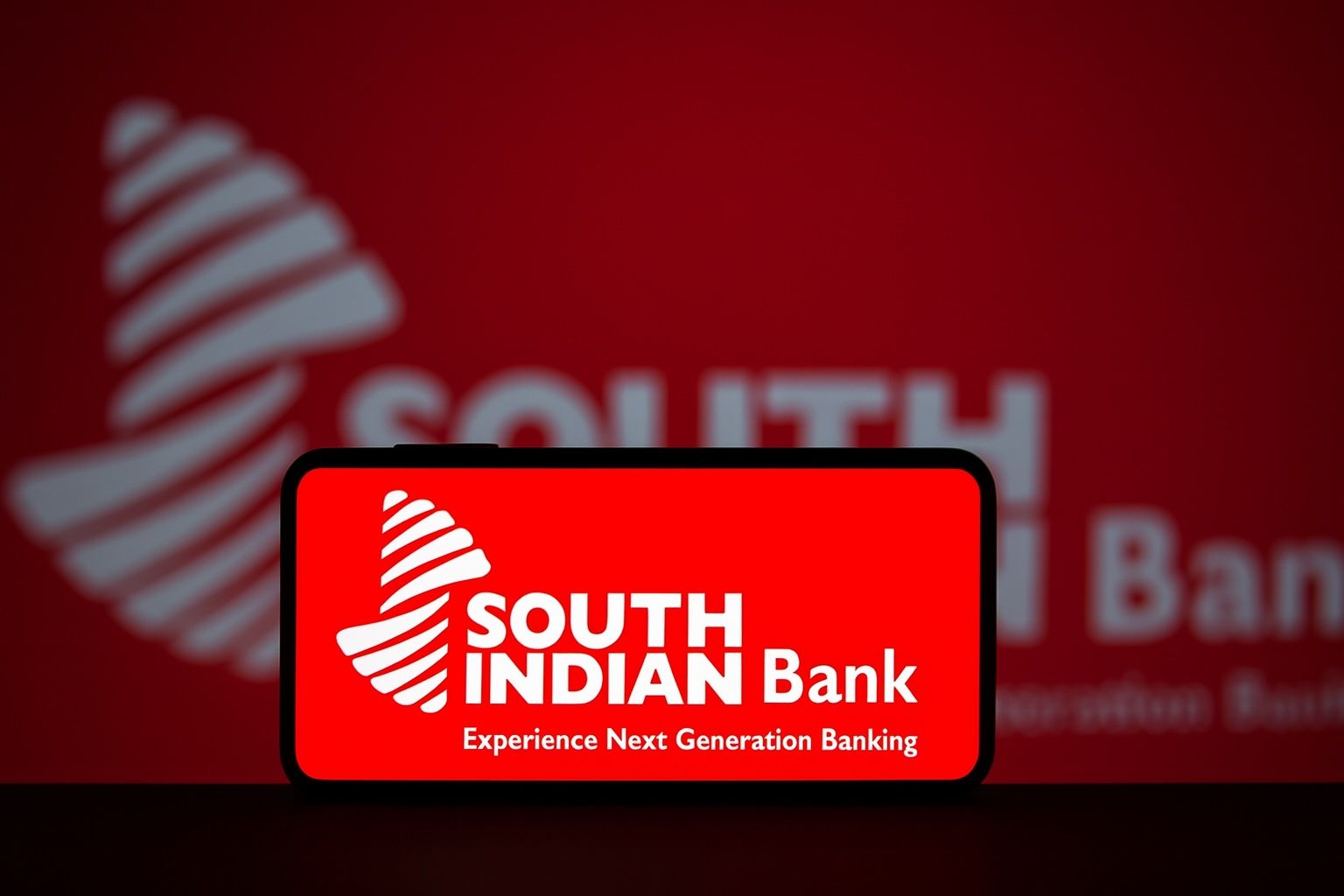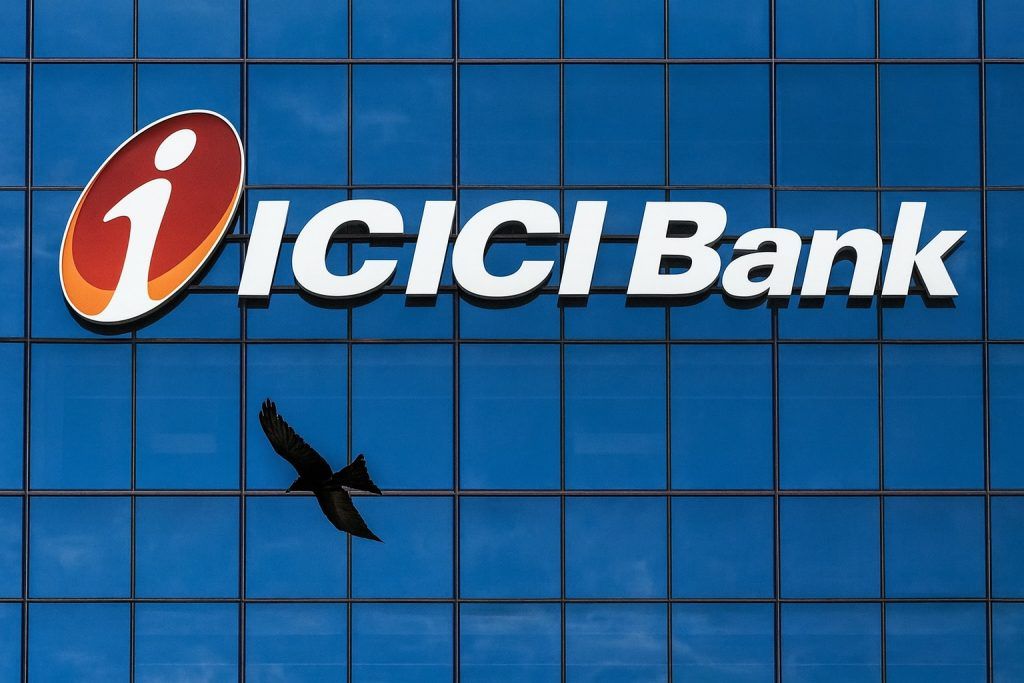- Record Rally: South Indian Bank’s share price jumped to around ₹38.4 on October 21, 2025, its highest level ever [1]. The stock traded ~1.7% higher on the day at ₹38.44 [2], extending a powerful rally – it’s up 50% year-to-date and over 14% in the past week alone [3].
- Surging Volume & Big Buyers: Investor enthusiasm is evident in trading volumes. On October 20, South Indian Bank’s volume on the BSE was 207.86 lakh shares by mid-session (nearly 9× its one-month average of 24.3 lakh) [4], with combined NSE/BSE turnover reportedly exceeding 25 crore shares by day’s end. Notably, high-net-worth investor Aditya Kumar Halwasiya acquired 2.01 crore shares (~0.76% stake) at ₹35.24 per share (a ₹70.8 crore deal) during the rally [5] – a strong vote of confidence. Technical analysts noted the stock’s bullish breakout, as it “surged 15.56% to ₹37.73 with a long bullish candle formation” on charts [6].
- Earnings Spark: The catalyst for this surge was a strong Q2 FY2025-26 earnings report. Net profit for July–September jumped 8.2% year-on-year to ₹351.6 crore [7] – beating street expectations – driven by a 26% jump in other income and sharply lower loan-loss provisions [8]. This helped offset an 8% decline in net interest income (₹808 crore) caused by narrower interest margins [9]. “Higher-than-expected profit in the September quarter on a sharp moderation in credit costs” propelled the stock to record highs, noted Business Today [10].
- Improved Fundamentals: The bank’s asset quality and fundamentals have markedly improved. Gross NPA ratio fell to 2.93% (from 4.40% a year ago) [11], and net NPA is down to 0.56%, indicating much cleaner books. Provisions dropped 43% YoY to ₹63 crore [12]. Loan growth is healthy (~9–10% YoY) [13], and capital adequacy stands at a strong 17.7% [14]. CEO P. R. Seshadri highlighted “healthy growth across all major segments – including Corporate, MSME, Housing, Auto and Gold loans – with a steadfast focus on maintaining asset quality,” underscoring a strategy of sustainable, low-risk growth [15].
- Analysts Bullish – Targets Raised: Brokerages are upbeat about South Indian Bank’s prospects. ICICI Securities reaffirmed a “Buy” rating and recently raised its target price to ₹42 per share [16], citing the bank’s consistent 1%+ Return on Assets and revival in its key MSME segment. The bank has delivered nine straight quarters of ~1% ROA and aspires to 20% growth in its retail/MSME loans going forward [17]. “NIM has bottomed out, assuming no further rate cuts,” the bank noted, signaling that net interest margin pressure may ease ahead [18]. According to Mint, 4 analysts now cover the stock with 0 “Sell” ratings (2 have a Strong Buy) [19]. Anand Rathi shares a similarly bullish view with a ₹42 target [20]. These targets imply room for further upside from current levels, though the stock has already surpassed some earlier targets (it touched ₹38+, above ICICI’s prior ₹38 goal [21]).
- Broader Bank Optimism: South Indian Bank’s rally comes amid a broader upswing in Indian bank stocks. Strong Q2 results from peers lifted sentiment – for instance, Punjab National Bank’s earnings beat sent its stock up ~3.9% [22], and mid-sized lenders Federal Bank and DCB Bank also surged (DCB +13% intraday after profit rose, Federal +5% on record revenue) [23] [24]. The Nifty PSU Bank index jumped 2.9% on Oct 20, its best day in four months [25], reflecting investor optimism that banks are entering a period of robust profitability. There’s also positive news of investment flows: a massive $3 billion stake purchase in RBL Bank by Emirates NBD boosted confidence in mid-tier banks [26]. Foreign investors have been increasing exposure to South Indian Bank too – FPIs now hold about 18% of the bank’s shares (up from last quarter) [27] – and the bank is widely held with no promoter ownership. [28] [29]
Stock Hits a New Peak on Earnings Momentum
South Indian Bank’s stock price has been on fire, soaring to an all-time high this week on the back of strong earnings and bullish investor sentiment. On October 21, the scrip touched approximately ₹38.4 during the Muhurat trading session (an auspicious one-hour market session on Diwali), building on the previous day’s big gains [30]. At ₹38+, the share is trading at levels never seen before in the bank’s history [31]. For context, the stock was hovering around ₹32 just before the results – meaning it’s leapt about 15–18% in two trading sessions alone.
This latest jump extends what has already been an impressive run in 2025. Year-to-date, South Indian Bank (SIB) has climbed over 50% in value [32], vastly outperforming broader market indices. In just the last five trading days, it has added about 14% [33], indicating accelerating momentum. The rally has lifted SIB’s market capitalization past ₹10,000 crore (~$1.25 billion) [34], firmly placing it among notable mid-tier banks in India. By comparison, many larger private banks are up only modestly this year, so SIB’s steep ascent has caught the market’s attention.
What’s driving this surge? Investors are cheering the bank’s September quarter (Q2 FY26) earnings and optimistic forecasts. The stock’s move on October 20 (when it spiked over 15%) was directly “thanks to a higher-than-expected profit in the September quarter on a sharp moderation in credit costs,” according to a report by Business Today [35]. In other words, South Indian Bank’s latest results came in better than anticipated, especially on the profitability and asset quality fronts – a welcome surprise that ignited heavy buying interest.
Q2 Results at a Glance: Profit Up, NIM Down but Asset Quality Shines
The July–September 2025 quarter numbers indeed painted a picture of an improving bank. SIB’s net profit jumped to ₹351.6 crore, an 8% year-on-year increase [36] (from ₹324 crore a year ago). While single-digit growth might not seem spectacular, it’s notable because many analysts expected lower profits due to margin pressures. The bank managed to beat expectations largely through other income and controlled expenses: fee income, treasury gains and other non-interest income surged 26% YoY to ₹516 crore [37], and provisions for bad loans were slashed by 43% to just ₹63 crore [38] (indicating fewer bad loans needing write-offs). These factors offset a decline in core interest income.
Net Interest Income (NII) – essentially the bank’s income from loans minus interest paid on deposits – came in at ₹808 crore for Q2, down about 8% from the same period last year [39]. This dip in NII was expected because net interest margin (NIM) tightened. SIB’s NIM for the quarter was 2.80%, down from ~3.24% a year prior [40]. The management attributed this to the interest rate environment: deposit costs rose and lending rates didn’t keep pace, compressing margins. “NIM declined 23 basis points QoQ to 2.8%… steeper for SIB vis-à-vis peers,” noted ICICI Securities in its review [41]. The good news is that SIB’s leadership believes this margin squeeze may have bottomed out. The bank indicated that NIM has likely hit its low point (assuming no further RBI rate cuts) [42]. In recent months, the Reserve Bank of India had paused and even trimmed policy rates slightly, which can pressure banks’ lending margins. If rates stabilize or credit yields improve, SIB’s NIM could start ticking up again, aiding future NII growth.
Crucially, asset quality improved significantly – a key factor boosting investor confidence. South Indian Bank’s Gross NPA (non-performing assets) ratio fell to 2.93% as of September 30 [43]. That’s down from 3.15% in the previous quarter and way down from 4.40% a year earlier [44]. In fact, this is one of the lowest GNPA levels the bank has seen in many years, reflecting a cleanup of legacy bad loans and prudent lending in recent quarters. Similarly, Net NPA sank to 0.56%, from around 1.3% a year ago [45]. SIB has essentially whittled net bad loans to about half a percent of its portfolio – which is better than many peer banks in its category. Lower NPAs meant lower provisioning needs, directly boosting profitability (as noted, provisions were just ₹63 crore this quarter [46] versus ₹110+ crore a year ago).
It appears the bank’s focus on realigning its loan book is paying off. SIB has been shifting towards retail and MSME (micro, small & medium enterprise) loans and reducing reliance on bulky corporate loans. In Q2, retail and MSME segments grew faster, which tend to yield steadier income. The bank said MSME loan growth revived ~6% sequentially and remains a “key focus segment” [47]. Overall advances were up ~9% YoY to ₹92,286 crore [48], and importantly, this growth is coming without compromising on credit quality. “The Bank recorded healthy growth across all major segments – including Corporate, MSME, Housing, Auto and Gold loans – with a steadfast focus on maintaining asset quality,” CEO P. R. Seshadri emphasized in a statement [49]. He noted that new loans are being onboarded with low risk profiles, and the strategy is “sustainable growth [and] prudent risk management” [50]. This prudent approach has allowed SIB to grow its loan book and profit while keeping bad loans in check, a balance that many previous managements struggled with.
Another positive is the bank’s strong capital position. Thanks to retained earnings and a recent capital raise (the bank had issued equity earlier in the year), the capital adequacy ratio is about 17.7% [51], comfortably above regulatory minimums. A healthy capital buffer means SIB can support further loan growth and also absorb any shocks, which gives investors additional comfort.
Investor Interest: Huge Volumes, Technical Breakout & Insider Moves
The stellar Q2 earnings acted as a magnet for investors – both retail traders and big institutions – leading to a frenzy of trading activity in SIB’s stock. On Monday, Oct 20, when the market first reacted to the results, South Indian Bank was among the most actively traded stocks across exchanges. By 11:45 AM that day, over 20.7 million shares (207.86 lakh) had already traded on the BSE, versus an average daily volume of just ~2.4 million [52]. By the end of that session, total volumes (NSE + BSE) were estimated to be well above 250 million shares (25 crore) – an astonishing turnover for a mid-cap bank. This volume spike (nearly 10x the norm) indicates heavy buying interest and possibly some institutional fund activity. In fact, exchange data showed the stock was on the radar of several big market participants.
Notably, one high-net-worth investor, Aditya Kumar Halwasiya, made headlines by purchasing 2.01 crore shares of South Indian Bank in a bulk deal [53]. This stake equals about 0.76% of the bank’s equity – a significant buy – and was acquired at an average price of ₹35.24 per share [54]. The total investment comes to roughly ₹70.8 crore. Such a sizable purchase by a known investor was seen as a bullish sign. It suggests that savvy players see further value in SIB even after the initial earnings pop. Market watchers often track bulk deals like these; in this case, Halwasiya’s buy reinforced the positive sentiment and possibly triggered follow-on buying from others who caught wind of the news.
From a technical analysis perspective, South Indian Bank’s chart sent an emphatic bullish signal. The stock broke out of its recent trading range in spectacular fashion. According to a Moneycontrol report, SIB’s share “saw [a] breakout and surged 15.56% to ₹37.73 with [a] long bullish candle formation” on Oct 20 [55]. In technical terms, a long bullish candle on high volume, coupled with a breakout to new highs, is a sign of strong upward momentum. The stock blew past its earlier 52-week high (~₹33-34) and even surpassed the intraday peak of ₹36.25 set that morning [56], confirming the breakout. All major moving averages have been left in the dust – with SIB now trading well above its 50-day and 200-day averages, which are in the low-30s and mid-20s respectively (indicative of the longer-term turnaround from a penny-stock level last year).
With no historical price resistance above (since ₹38 is uncharted territory), traders are eyeing round-number levels like ₹40 as the next possible hurdle. If the stock can consolidate above ₹38, the ₹40 mark could be a short-term target, and beyond that some optimistic voices are even talking about ₹50. On trading forums, the buzz is palpable – some bullish commentators have drawn comparisons to Axis Bank’s early days, speculating that South Indian Bank, with its tech-savvy approach, could replicate Axis Bank’s multi-year ascent (Axis famously went from ₹2.5 in the 1990s to over ₹1,000 now) [57]. Such projections should be taken with a grain of salt, but they reflect the exuberant investor sentiment currently surrounding SIB.
It’s also worth noting that ownership patterns hint at growing confidence from smart money. As of the September quarter, Foreign Portfolio Investors (FPIs) held 17.91% of South Indian Bank’s shares [58] – a stake that has increased from the previous quarter [59]. Clearly, some foreign funds have been accumulating positions, perhaps anticipating the bank’s turnaround. Domestic mutual funds hold about 10% [60] (slightly reduced recently as some booked profits), while retail investors and others hold the rest. The bank has no promoter holding (0%) [61], meaning it’s entirely publicly owned – so the fact that institutions (FII/FPI) are willing to up their stake is a positive sign on governance and growth expectations.
What Are Analysts Saying? Forecasts and Ratings
Market analysts and brokerage houses have generally been positive on South Indian Bank after seeing the Q2 numbers and stock’s momentum, though some caution that the easy gains may have been made. On the bullish side, ICICI Securities — which has been tracking the bank’s turnaround for several quarters — reiterated its “Buy” recommendation. Initially, ICICI Sec had a target price of around ₹38 (which the stock has now reached), but post-earnings they are looking higher. The brokerage highlighted the bank’s continued 1%+ Return on Assets (RoA) and improving asset mix, and set a target of ₹42 in their latest note [62]. They argue that despite the recent rally, valuations remain attractive – by their estimates, SIB still trades at roughly 0.9 times book value and a TTM P/E of ~5.5 (versus the private bank sector’s ~9–10) [63]. Even another source pegs the P/E around 7.5 at current prices [64], which is still cheap for a profitable bank. This suggests the stock isn’t expensive if the bank can sustain growth. ICICI Sec also noted that SIB’s focus on MSME/retail loans should drive steady growth; in fact, management has “aspirations of 20% growth in MSME/retail” going forward [65]. They believe credit costs (loan loss charges) will remain benign given strong asset quality, and that net interest margin will stabilize. “South Indian Bank said [its] NIM has bottomed out, assuming no further rate cuts,” the brokerage pointed out, indicating that margins could improve if the interest rate cycle turns favorable [66].
Other analysts are echoing optimism. Brokerage Anand Rathi in July had a ₹42 target as well for SIB [67], and that was when the stock was under ₹30 – they saw a re-rating opportunity given SIB’s low 0.8x P/B valuation at the time [68]. With the bank delivering on earnings, such price targets appear increasingly plausible (₹42 is only ~9% above the latest price). Importantly, no major analyst is bearish on the stock at the moment. According to Mint market data, among the few analysts covering SIB, none has a Sell rating – two categorize it as a Strong Buy and the rest as holds or moderate buys [69]. This consensus reflects a broader belief that the bank’s turnaround under CEO Seshadri is on firm footing.
We also saw a brokerage upgrade in narrative: Free Press Journal reported that ICICI Securities continues to maintain a bullish stance and had (earlier) put a ₹38 target on the stock [70] along with projections of ~11–12% loan CAGR and ~0.9% RoA by FY27. Those metrics underline that even by 2027, SIB might still have a lower RoA than bigger private banks (which are ~1.5%+). So the bull case is that there’s room for improvement, and as SIB catches up on performance, its valuation multiples (P/E, P/B) could rise closer to peers. It helps that SIB’s peer group – small private banks like Federal, DCB, City Union Bank, etc. – have been reporting good results as well, lending credibility to SIB’s numbers.
That said, a few analysts advise caution after the sharp stock price increase. The key risk noted is the narrow NIM: if interest rates were to be cut further by RBI (to stimulate the economy), banks like SIB with already thin margins could see their NII under further pressure. SIB’s management is aiming to raise NIM back toward 3% (from 2.8% now) [71], but there’s no set timeline and it depends on factors like low-cost deposit growth and yield on advances. Additionally, competition in the South Indian market – from larger banks and new-age lenders – means SIB must continue executing well on its tech and service offerings to retain and grow customers. For now, though, most observers feel the bank’s worst days are behind it, given the drastic improvement in bad loans and consistent profitability.
Macro Tailwinds and Outlook
Zooming out, South Indian Bank is benefiting from a favorable macro backdrop for banks. India’s economy has been growing steadily, and credit demand is resilient. The stock’s rise coincides with an overall banking sector rally this month. Investors have been rotating into financial stocks expecting that interest rates might have peaked and that bank earnings will improve. In fact, Indian equities hit one-year highs on Oct 20, led by bank stocks, after a slew of strong bank earnings and ahead of festive holidays [72]. The sentiment was buoyed by news like Punjab National Bank’s profit beat (PNB’s Q2 profit fell but NII hit a record, sparking a 3.9% jump in its stock) [73] and Reliance Industries’ robust results lifting indices [74]. Even public sector banks (PSU banks) that had lagged saw a big move – the Nifty PSU Bank index’s 2.9% jump on Oct 20 was its best day in four months [75], reflecting renewed confidence in the sector.
There are also policy tailwinds on the horizon. As TechStock² noted, some domestic brokerages (like Citi and ICICI Sec) are factoring in possible RBI rate cuts in coming quarters and recent tax reforms as positives for banks [76]. Rate cuts, while they can squeeze NIM in the very short term, tend to boost loan growth and reduce defaults – a net positive for well-managed banks. Additionally, the Indian government’s continued push on credit expansion, infrastructure spending, and a stable inflation outlook could foster an environment where banks thrive. South Indian Bank, being a smaller bank, stands to gain market share if it leverages its strong capital base and digital initiatives (it has been focusing on digital transformation and won some tech awards in 2024).
Another macro factor is industry consolidation and investments. The news that Emirates NBD (a Dubai-based bank) will invest $3 billion for a 60% stake in RBL Bank is a landmark deal – the largest FDI in Indian banking [77]. While that’s a different bank, it signals foreign investors’ appetite for Indian banks with growth potential. It also sets valuation benchmarks; RBL’s deal, for example, values it attractively and will bolster its capital. Such developments often cause investors to re-rate similar banks. SIB’s stock, in fact, may have caught some of this halo effect – as both RBL and SIB are mid-tier banks focusing on retail/MSME, and if a global player sees long-term value in one, others can get a sentiment boost.
Looking ahead, what can investors expect? In the near term, markets will observe how South Indian Bank sustains its improved performance. The December-quarter (Q3) results (due in January) will be the next checkpoint. Consistency will be key: another quarter of ~₹300+ crore profit with stable or rising NIM and low NPAs would reinforce the turnaround story. Any positive surprise – say, stronger loan growth above 10% or NIM uptick – could propel the stock further, perhaps firmly into the ₹40s. Most analysts’ 12-month price targets now cluster around ₹40–45, which implies modest upside from current levels [78] [79]. However, if the bank’s profitability trajectory accelerates (for example, if RoA moves toward 1.2%+ in coming years), there could be scope for those targets to be revised upward.
On the flip side, after such a sharp rally, valuations aren’t as dirt-cheap as before. At ₹38, SIB trades at roughly 0.9–1.0x its book value and ~6–7x earnings – still low, but not the bargain 0.5x book it was at the start of 2023 when NPAs were higher. Any misstep – such as a spike in NPAs or a drop in profit – could trigger some profit-booking. Additionally, broader market volatility (global factors, interest rate changes by central banks, etc.) could affect sentiment.
For now, though, South Indian Bank finds itself in a sweet spot: it has shaken off a troubled past, delivered steady profits, and caught the market’s eye at a time when banking stocks are in favor. The stock’s journey from sub-₹10 levels a couple of years ago to nearly ₹40 today underscores a remarkable turnaround. If the management continues to execute – growing the franchise in its stronghold markets of South India, keeping costs and credit quality tight – many believe this bank could justify an even higher valuation. Investors have clearly re-rated SIB upward, and all eyes will be on whether it can maintain the growth momentum to perhaps one day approach the league of larger mid-sized banks.
Bottom line: South Indian Bank’s share price surged to record highs on Oct 21, 2025, fueled by robust earnings and optimism about its trajectory. The stock’s swift rise – and heavy trading interest behind it – signals renewed trust in the bank’s prospects after years of underperformance. With analysts and even insiders upbeat, SIB has emerged as an exciting turnaround story in India’s banking space. The coming quarters will tell if this rally has more legs – and if the ₹50 milestone (roughly another 30% gain from here) could indeed be the next target in sight. Investors will be watching closely, but for now, South Indian Bank has given its shareholders plenty of reason to celebrate this festive season.
Sources: South Indian Bank market data and live quotes from Mint [80] [81]; Q2 FY2025-26 earnings details from Economic Times and Livemint [82] [83]; Analyst commentary from Business Today and Moneycontrol [84] [85]; Volume and trading insights from Business Standard [86]; Sector context from TechStock² (ts2.tech) and Reuters [87] [88]; Additional reporting from Free Press Journal and PTI/Business Standard [89] [90].
References
1. www.businesstoday.in, 2. www.livemint.com, 3. www.livemint.com, 4. www.business-standard.com, 5. www.moneycontrol.com, 6. www.moneycontrol.com, 7. economictimes.indiatimes.com, 8. www.livemint.com, 9. www.livemint.com, 10. www.businesstoday.in, 11. www.livemint.com, 12. www.livemint.com, 13. www.livemint.com, 14. www.livemint.com, 15. www.livemint.com, 16. www.businesstoday.in, 17. www.businesstoday.in, 18. www.businesstoday.in, 19. www.livemint.com, 20. www.moneycontrol.com, 21. www.freepressjournal.in, 22. ts2.tech, 23. economictimes.indiatimes.com, 24. economictimes.indiatimes.com, 25. ts2.tech, 26. www.freepressjournal.in, 27. www.livemint.com, 28. www.5paisa.com, 29. www.5paisa.com, 30. www.livemint.com, 31. www.businesstoday.in, 32. www.livemint.com, 33. www.livemint.com, 34. www.5paisa.com, 35. www.businesstoday.in, 36. economictimes.indiatimes.com, 37. www.livemint.com, 38. www.livemint.com, 39. www.livemint.com, 40. www.business-standard.com, 41. www.businesstoday.in, 42. www.businesstoday.in, 43. www.livemint.com, 44. www.livemint.com, 45. www.livemint.com, 46. www.livemint.com, 47. www.businesstoday.in, 48. www.livemint.com, 49. www.livemint.com, 50. www.livemint.com, 51. www.livemint.com, 52. www.business-standard.com, 53. www.moneycontrol.com, 54. www.moneycontrol.com, 55. www.moneycontrol.com, 56. www.freepressjournal.in, 57. www.moneycontrol.com, 58. www.5paisa.com, 59. www.livemint.com, 60. www.5paisa.com, 61. www.5paisa.com, 62. www.businesstoday.in, 63. www.livemint.com, 64. www.5paisa.com, 65. www.businesstoday.in, 66. www.businesstoday.in, 67. www.moneycontrol.com, 68. rakesh-jhunjhunwala.in, 69. www.livemint.com, 70. www.freepressjournal.in, 71. www.business-standard.com, 72. www.reuters.com, 73. ts2.tech, 74. www.reuters.com, 75. ts2.tech, 76. ts2.tech, 77. www.freepressjournal.in, 78. www.businesstoday.in, 79. www.moneycontrol.com, 80. www.livemint.com, 81. www.livemint.com, 82. economictimes.indiatimes.com, 83. www.livemint.com, 84. www.businesstoday.in, 85. www.moneycontrol.com, 86. www.business-standard.com, 87. ts2.tech, 88. www.reuters.com, 89. www.freepressjournal.in, 90. www.business-standard.com







